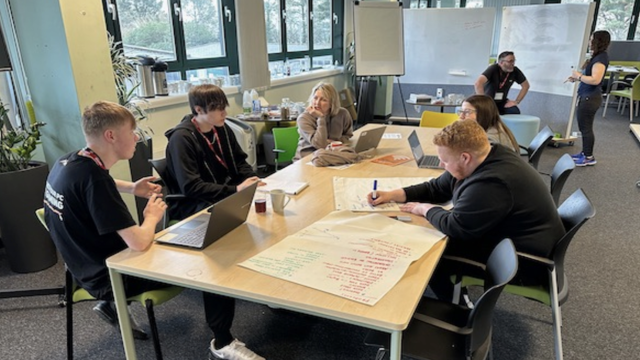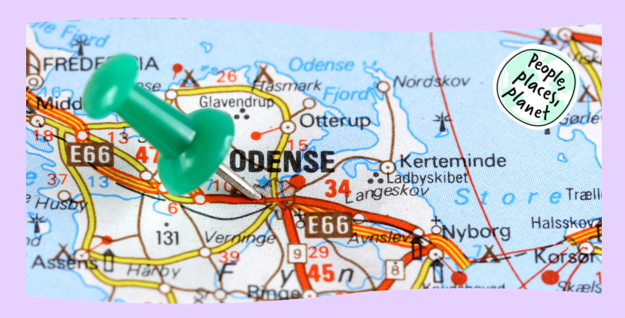Open source content management system Umbraco recently set up a community group about sustainability, which I’m honoured to be a part of.
Our aim is to make Umbraco part of the solution to the internet’s emissions problem. The team comes from a range of organisations and backgrounds. We also have Umbraco employees in the group, which is important because the recommendations we're pushing will have an impact across its development community and core product suite.
With that context, Umbraco invited us to come to Denmark for three (ish) days and work together as part of their excellent community engagement programme. They have loads of different community teams (accessibility, D&I, back office, package deployments etc) who have a genuine influence on the way the product suite is developed.
Choosing the sustainable path
I know you're already thinking, why is a sustainability team travelling thousands of collective miles to work together? I really like remote working, especially in the shipping container I converted during one of the Covid lockdowns. Also, remote workers emit less emissions. Therefore, leaving my house for work rarely happens. But I do think it's valuable when you're working together on something new and ambiguous which doesn't have an obvious direction or deliverable.
So, I wanted to go, but I couldn't bring myself to fly. I talk a lot about the pollution humans have choked the planet with and wanted to show this trip could be done differently. So I got the train from East Sussex (where I live) to Odense in Denmark. Well, actually I got lots of trains. 11 of them. It should have been 10 but I'll get to that later…
Having talked to people about it and seeing the unconvinced looks on their faces, it was clear I needed to do some analysis about whether the trip was worth it. So I compared three different ways of getting to Odense from East Sussex:
-
the most convenient = taxi to my nearest airport (Heathrow), fly to Copenhagen and then a train to Odense.
-
the cheapest = Trains from Battle to Luton, fly to Billund and then a train to Odense.
-
the lowest carbon = Trains from Battle to St Pancras, Eurostar to Brussels, Brussels to Cologne, Cologne to Hamburg and Hamburg to Odense. This included a stopover in Cologne on the way there, and in Brussels on the way back.
Navigating the train dilemma
However, I very nearly threw in the towel before the analysis stage was even finished! The train booking websites I was using were not geared for booking stopovers. I knew the broad route I wanted to go thanks to the brilliant routezero.world website, but it didn’t offer direct booking.
I wasn’t really sure what to do. Thankfully, I stumbled across seat61.com, which was exactly what I needed for this unusual journey. It gave me recommendations written by a person (Mark Smith), not the results of an algorithm (yes, LLMs I mean you). Mark has travelled around Europe by train and has detailed advice for the best routes, where to eat based on how long your changeovers are and how to negotiate some of the not so great functionality on the various booking websites.
This solved my problem and I was ready to book everything I needed to. The point I'm trying to make is, even at this stage, train travel is on the backfoot as an alternative to flying. I put a lot of effort into getting to this point, and given the amount of booking I needed to do,there was still a fair amount of effort to go. This was not helped by the fact that there was an event in Cologne, which meant that I couldn’t book my hotel there through staze.com (a hotel booking website where you can order results by the emissions of the hotel) because it was triple the normal price. So, I got a little Airbnb instead.
Cost and emissions analysis and the carbon tradeoff
But after getting it all booked, how did all of the options compare in terms of cost and emissions? And yes, I do have a much fuller spreadsheet that details the below more, let me know if you want to see it.
|
Route |
Cost |
Emissions |
|
Most convenient |
£526 |
413kg CO2e |
|
Cheapest |
£124 |
263kg CO2e |
|
Lowest carbon |
£580 |
44kg CO2e |
So, if I wanted to travel as cheaply as possible, I could do it for about ¼ of the price of travelling via train but create four times as many emissions. If I wanted to travel conveniently I could do it for roughly the same price as getting the train but would create 10 times as many emissions.
How is that possible? Airlines benefit from not having to pay taxes or excise duties for the kerosene used in jet fuel. Railways don’t benefit from anything similar and with the disconnected nature of the network across the UK and Europe, finding common ground reducing ticket prices for journeys that span multiple countries and days takes serious negotiations.
Also, let’s not over complicate it. New infrastructure isn’t needed, just cross governmental and organisational collaboration. The €49 rail tickets that popped up over Europe during the last couple of summers prove that this kind of thing is possible.
Darting off to Denmark
Getting back to my journey. I was setting off Tuesday morning and arriving in Odense Wednesday afternoon. I knew that meant I wasn’t going to fit in any video calls during that time because there was no guarantee on my location or what the internet connection would be like. So, all the relevant people on the projects I was working on knew I was best contacted on Slack or email for a couple of days, which isn’t unusual.
I didn’t even need to think much about the work I was going to do en route. Everything I needed was available via G Suite or other SaaS tools so I just needed a bit of internet connection every now and then to save my work.
All the trains were spacious, quiet, clean and walking up and down 16 coaches is a decent walk when you need to stretch your legs! And they all had decent enough wifi. Also, when you think about food as much as I do and you know your changeovers are tight,having food and drink markets at major international stations meant I was spoiled for choice, even as a vegan.
There was only one issue with a delay/cancellation during the trip, a cancelled train from Brussels to Cologne. When I asked for help at the station, I got some not very useful advice to work my way across Belgium on different commuter trains, when I should have just waited for the next direct train which was only two hours afterwards. That actually worked out fine though because by the time I worked my way across Belgium I had a little bit of time to find some decent food in the station before I picked up my connection.
Delays and cancellations: Trains vs. Flights
Now, let’s compare my train cancellation to the people that flew to Denmark. There was one person who had their flight cancelled on their way to the airport, so spent the whole day there waiting for the next one. On the way back, multiple flights were cancelled, leaving people to stay over for another night, meaning I beat them home!
All forms of transport have delays and cancellations, but those were certainly less of an issue for me because of the frequency of other services/routes.
The long trip home
On the way home, I did an intense 12-hour day of travelling (all the way from Odense to Brussels) so I could sleep in Brussels and get an early Eurostar back to the UK in the morning. This sounds like a long day, but it didn’t feel like it. It was split across three trains with decent changeovers all conveniently around eating times! Between reading my list of open tabs and e-newsletters, listening to podcasts and looking out of the window, it actually flew by (pun intended).
So, would I recommend it? Absolutely! If you’re able to embrace the constraints then it really does make for a great way to travel. If you rethink what matters to you given the context of your journey then it has to be a viable alternative. By that I mean, if I had a family emergency, I would take the quickest possible route, which in this case would have been flying. Butspeed wasn’t the lead factor for this journey. Thankfully neither was the cost; Umbraco paid for travel and accommodation, which I cleared with them first.
And cost really is the big disappointment in all of this. It’s very often said that all of the things we need to do to reduce our impact on the planet already exist. We just need to do them,scale them and stop doing the negative stuff. Unfortunately the State of Climate Action Report has found that out of 42 measures, only one is on track; six are going in the opposite direction, with the rest in various levels of off track.
Ensuring that train travel can compete with flying on cost and ease is vital to making the carbon reductions needed. Simply being a lower carbon alternative isn’t going to result in the scale of change that is required. As with so many aspects of our economy, the worse it is for the planet, the more it is subsidised and incentivised.
Latest stories
Transformation is for everyone. We love sharing our thoughts, approaches, learning and research all gained from the work we do.

An epic hackathon with students from City College Plymouth
Discover how we’re empowering students, fostering creativity and building digital skills for the future.
Read more
B-cause businesses can and should do better
Sharing how our commitment to serving all our stakeholders extends beyond B Corp certification
Read more
B Corp, B-cause change starts within
It’s B Corp Month, and we’re sharing a look at what we think it means to be a B Corp. This way forward!
Read more

